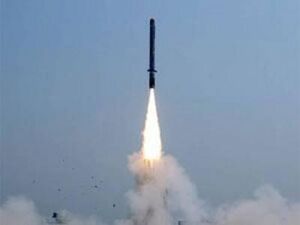Trebuchet Missile
| Trebuchet | |
|---|---|
 | |
| Type | Anti-Shipping Heavy Missile (ASHM) |
| Service history | |
| In service | 2012-present |
| Used by | see operators |
| Production history | |
| Manufacturer | BAU Systems |
| Specifications | |
| Weight | 2,600 kg (5,700 lb) Air launch 3,100 kg (6,800 lb) Surface and Submarine launch |
| Length | 8.8 m (29 ft) |
| Diameter | 0.6 m (24 in) |
| Blast yield | 200-300kg armour-piercing warhead |
| Propellant | Launch: Solid-fuel booster Primary: Liquid-fuel Ramjet |
Operational range | 250 nmi (460 km) |
| Flight altitude | 1-2 m (3.3-6.6 ft) |
| Speed | 2,300 mph (3,700 km/h)+ |
Guidance system | Primary course guidance by INS Terminal guidance by active radar/GPS/SATGUI |
Launch platform | fixed-wing aircraft, surface ships, ground-based mobile launchers |
The Trebuchet is a supersonic cruise missile utilising ram jet technology to maintain supersonic speeds over a long duration. It is launched from air, land, sea and submarine platforms developed by BAU Systems over a four-year period for service with the Federation Navy. The weapon has since been adopted by the Belfrasian Air Force and has interest in the Belfrasian Army for usage on static launchers for area denial.
Development of the weapon began in 2005 with the Federation Navy requesting a heavy missile capable of reliably terminating or 'mission killing' - When the target is no longer capable of carrying out attacks and has to withdraw - targets. Testing for the weapon began in 2008 with early variants, under the project name 'Seakiller Missile', had success against immobile platforms when launched from surface vessels. The resulting weapon had a shorter range than initially expected, but is capable of accelerating to supersonic speeds with fuel conservation and efficiency focusing on this part of the weapons journey. A protective cap on the front of the weapon covers the ram-jet when stowed and, during launch, has solid-fuel exhausts that help adjust the weapons heading during a vertical launch (From submarines or vertical launchers on land or on surface vessels).
Since it's adoption by the Federation Navy and Air Force in 2012, the weapon has seen heavy usage as a stand-off weapon, although it's deployment in the Navy has been almost exclusively aboard Submarines.
Overview
The Trebuchet is a supersonic cruise missile capable of striking surface and land targets, travelling at supersonic speeds (upwards of Mach 2.8+) for the majority of it's flight. It is capable of adaptive flight profile usage for it's environment and intended target and contains next-generation Friend-Foe identification to allow it to pass friendly vessels without risk of accidentally targeting them. Standard attack procedure calls for the missile to ascent to an altitude of 50,000 ft after launch by solid-fuel booster to allow for an economic, fuel-saving flight. As it approaches it's target the missile will descent to an altitude of 5-10 meters and expends the rest of it's fuel for a rapid acceleration attack profile. In the event of attacking targets with advanced anti-missile technology, the missile is capable of holding a flight profile of under 50 meters for the flight time, however this drastically reduces range as a result of increased fuel usage.
Despite being designed initially for surface combatants, the missile has been altered for use on submarines, air vehicles and land platforms. These alterations saw the missile adopt a land attack variant that varries a fragmentation-blast or penetration warhead as opposed to the semi-armour piercing warhead.